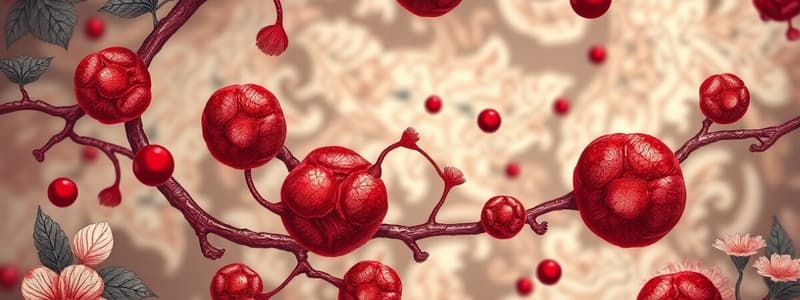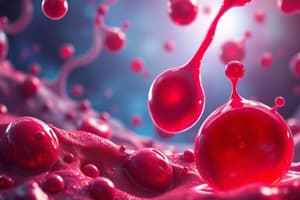Podcast
Questions and Answers
Which process is directly associated with primary hemostasis?
Which process is directly associated with primary hemostasis?
- Formation of a platelet plug (correct)
- Stabilization of fibrin strands by factor XIII
- Activation of the coagulation cascade
- Dissolution of the clot through plasmin activation
Secondary hemostasis enhances the initial platelet plug through which of the following mechanisms?
Secondary hemostasis enhances the initial platelet plug through which of the following mechanisms?
- Directly activating platelets without the need for initial adhesion.
- Reinforcing the platelet plug with fibrin. (correct)
- Inhibiting the coagulation cascade to prevent excessive clotting.
- Dissolving the initial platelet plug to allow for tissue repair.
How do negative feedback loops regulate hemostasis?
How do negative feedback loops regulate hemostasis?
- By directly activating platelets to ensure rapid clot formation.
- By continuously amplifying the coagulation process until an external intervention occurs.
- By preventing the activation of antithrombin, allowing for continuous thrombin activity.
- By inhibiting factors that promote clotting, thus preventing excessive clot formation. (correct)
In which organ are most clotting factors synthesized?
In which organ are most clotting factors synthesized?
What is the primary function of antithrombin in the hemostatic process?
What is the primary function of antithrombin in the hemostatic process?
How does fibrinolysis contribute to hemostasis?
How does fibrinolysis contribute to hemostasis?
What clinical indication does an elevated D-dimer level typically suggest?
What clinical indication does an elevated D-dimer level typically suggest?
What is the key difference between a thrombus and an embolus?
What is the key difference between a thrombus and an embolus?
What are arterial thrombi primarily composed of?
What are arterial thrombi primarily composed of?
What is the primary composition of venous thrombi?
What is the primary composition of venous thrombi?
Hemophilia is characterized by:
Hemophilia is characterized by:
What is the primary underlying cause of hemophilia?
What is the primary underlying cause of hemophilia?
What are the three major factors contributing to the etiology of deep vein thrombosis (DVT), as described by Virchow's triad?
What are the three major factors contributing to the etiology of deep vein thrombosis (DVT), as described by Virchow's triad?
What is a critical early sign or symptom that a nurse should be aware of when monitoring a patient for pulmonary embolism (PE)?
What is a critical early sign or symptom that a nurse should be aware of when monitoring a patient for pulmonary embolism (PE)?
A patient on antiplatelet medication is being monitored by a nurse. Which of the following signs should the nurse be vigilant for as an indication of potential hemorrhage?
A patient on antiplatelet medication is being monitored by a nurse. Which of the following signs should the nurse be vigilant for as an indication of potential hemorrhage?
How does aspirin exert its antiplatelet effect?
How does aspirin exert its antiplatelet effect?
What is the mechanism of action of clopidogrel as an antiplatelet medication?
What is the mechanism of action of clopidogrel as an antiplatelet medication?
How do all anticoagulants generally affect the coagulation process?
How do all anticoagulants generally affect the coagulation process?
What lab value requires close monitoring in patients taking warfarin?
What lab value requires close monitoring in patients taking warfarin?
Direct oral anticoagulants (DOACs) are often preferred over warfarin because:
Direct oral anticoagulants (DOACs) are often preferred over warfarin because:
Flashcards
Primary Hemostasis
Primary Hemostasis
Formation of a platelet plug as the body's initial response to stop bleeding.
Secondary Hemostasis
Secondary Hemostasis
The coagulation cascade that stabilizes the platelet plug formed in primary hemostasis using fibrin.
Antithrombin Role
Antithrombin Role
A protein in plasma that inhibits thrombin and other clotting factors, preventing excessive clotting.
What is D-dimer?
What is D-dimer?
Signup and view all the flashcards
What is a thrombus?
What is a thrombus?
Signup and view all the flashcards
What is an embolus?
What is an embolus?
Signup and view all the flashcards
Arterial thrombi consist of:
Arterial thrombi consist of:
Signup and view all the flashcards
Venous thrombi consist of:
Venous thrombi consist of:
Signup and view all the flashcards
Hemophilia
Hemophilia
Signup and view all the flashcards
DVT Etiology
DVT Etiology
Signup and view all the flashcards
Antiplatelet Medications
Antiplatelet Medications
Signup and view all the flashcards
Aspirin MOA
Aspirin MOA
Signup and view all the flashcards
Clopidogrel MOA
Clopidogrel MOA
Signup and view all the flashcards
Eptifibatide MOA
Eptifibatide MOA
Signup and view all the flashcards
Anticoagulants
Anticoagulants
Signup and view all the flashcards
Unfractionated Heparin MOA
Unfractionated Heparin MOA
Signup and view all the flashcards
Enoxaparin (LMWH) MOA
Enoxaparin (LMWH) MOA
Signup and view all the flashcards
Warfarin MOA
Warfarin MOA
Signup and view all the flashcards
Dabigatran MOA
Dabigatran MOA
Signup and view all the flashcards
Alteplase MOA
Alteplase MOA
Signup and view all the flashcards
Study Notes
- Primary hemostasis forms the platelet plug.
- Secondary hemostasis is the coagulation cascade, which reinforces platelets with fibrin.
- Hemostasis operates through positive and negative feedback loops.
- Clotting factors are made in the liver.
Hemostasis
- Antithrombin inhibits thrombin and other coagulation factors, preventing excessive clotting.
- Fibrinolysis occurs through the action of plasmin, which breaks down fibrin.
- D-dimer indicates that fibrinolysis has occurred, as it is a breakdown product of cross-linked fibrin.
- Thrombus refers to a blood clot that forms inappropriately within a blood vessel or the heart
- Embolus is a thrombus that has broken loose and is travelling in the bloodstream.
- Arterial thrombi or white clots are made mostly of platelets.
- Venous thrombi or red clots are made mostly of fibrin and red blood cells.
- Hemostasis measurements determine the time it takes for blood to clot.
Hemophilia
- Hemophilia manifestations include prolonged bleeding, easy bruising, and joint bleeding.
- Hemophilia is typically caused by genetic mutations which affect the production of clotting factors.
DVT (Deep Vein Thrombosis)
- Three variables for DVT etiology include Virchow's Triad, hypercoagulability, stasis, and endothelial injury.
- Risk factors associated with DVT are immobility, surgery, trauma, cancer, pregnancy, and certain medications.
- Clinical manifestations of DVT include pain, swelling, warmth, and redness in the affected limb.
- DVT treatment involves anticoagulation, thrombolysis, and compression stockings.
Pulmonary Embolism
- PE can occur when a DVT breaks loose and travels to the lungs, lodging in the pulmonary arteries.
- Signs and symptoms of PE include shortness of breath, chest pain, cough, rapid heart rate, and dizziness.
Signs of Hemorrhage
- Signs of hemorrhage in patients taking antiplatelets, anticoagulants, or thrombolytics include unusual bruising, bleeding gums, blood in urine or stool, and severe headaches.
Antiplatelet Medications
Aspirin
- Aspirin's MOA involves inhibiting cyclooxygenase, preventing the production of thromboxane A2, a potent platelet aggregator.
- Aspirin's adverse effects include bleeding, gastrointestinal upset, and increased risk of ulcers.
- Aspirin's contraindications include hypersensitivity, active bleeding, and bleeding disorders.
- Clinical considerations for aspirin involve monitoring for bleeding and educating patients about the risks.
Clopidogrel
- MOA of clopidogrel involves blocking the ADP receptor on platelets, inhibiting platelet activation and aggregation.
- Clopidogrel's adverse effects consist of bleeding, thrombocytopenia, and hypersensitivity reactions.
- Clinical considerations for clopidogrel involve monitoring for bleeding and ensuring that patients are properly educated about the risks.
Eptifibatide
- Eptifibatide's MOA involves blocking the glycoprotein IIb/IIIa receptor on platelets, which inhibits platelet aggregation.
- Eptifibatide's adverse effects include bleeding, thrombocytopenia, and hypersensitivity reactions.
- Clinical considerations for eptifibatide involve administering intravenously and monitoring for bleeding.
Anticoagulants
- All anticoagulants decrease the production of fibrin.
Parenteral Anticoagulants
Unfractionated Heparin
- Unfractionated Heparin MOA involves activating antithrombin, which then inhibits thrombin and other coagulation factors.
- Adverse effects of Unfractionated Heparin consist of bleeding, heparin-induced thrombocytopenia (HIT), and hypersensitivity reactions.
- Contraindications of Unfractionated Heparin include active bleeding, severe thrombocytopenia, and hypersensitivity.
- Routes of Unfractionated Heparin are intravenous or subcutaneous.
- Monitoring Unfractionated Heparin involves the aPTT test.
- Protamine is the reversal agent for Unfractionated Heparin.
Heparin Induced Thrombocytopenia
- Suspect HIT when platelet count drops significantly after heparin administration.
- Treatment/interventions for HIT involve stopping heparin and administering a different anticoagulant.
Enoxaparin (LMWH)
- Enoxaparin (LMWH) MOA involves activating antithrombin.
- Enoxaparin (LMWH)'s adverse effects include bleeding, thrombocytopenia, and injection site reactions.
- Routes for Enoxaparin (LMWH) are subcutaneous.
- Dosing of Enoxaparin occurs 1-2 times per day
- Monitoring of Enoxaparin usually does not required.
- Protamine is the reversal agent for Enoxaparin.
- Enoxaparin should be administered subcutaneously into the abdomen
Oral Anticoagulants
Warfarin
- Warfarin's MOA includes interfering with the production of vitamin K-dependent clotting factors.
- Warfarin's adverse effects include bleeding, and skin necrosis.
- Warfarin's contraindications are pregnancy, active bleeding, and bleeding disorders.
- Drug interactions of Warfarin involve several medications and foods that can affect its efficacy.
- INR (International Normalized Ratio) is used to monitor Warfarin.
- Vitamin K is the reversal agent for Warfarin.
- Counseling points for patients on Warfarin include maintaining a consistent diet, monitoring for signs of bleeding, and taking medication as directed.
- There is a therapeutic delay with Warfarin use due to the time it takes to deplete existing clotting factors.
- Bridging refers to the use of a short-acting anticoagulant, such as heparin, to provide immediate anticoagulation while warfarin reaches therapeutic levels.
DOACs (Direct Oral Anticoagulants)
- Adjust dose and monitor all DOACs for renal and hepatic function.
- Dabigatran MOA is a direct thrombin inhibitor.
- The reversal agent for Dabigatran is idarucizumab.
"ban" drugs
- "ban" drugs MOA includes direct factor Xa inhibitors.
- The reversal agent of "ban" drugs is andexanet alfa.
- DOACs are mostly preferred over warfarin due to their predictable pharmacokinetics, rapid onset of action, and lower risk of bleeding.
Thrombolytic
Alteplase
- Alteplase's MOA involves converting plasminogen to plasmin, which then breaks down fibrin clots.
- Alteplase is indicated for treating acute ischemic stroke, pulmonary embolism, and myocardial infarction.
- Adverse effects of Alteplase consist of bleeding, and hypersensitivity reactions.
- Contraindications of Alteplase consist of active bleeding, recent surgery, and uncontrolled hypertension.
- Time-dependent effectiveness of Alteplase involves administering the drug as soon as possible after the onset of symptoms to maximize its benefits.
Studying That Suits You
Use AI to generate personalized quizzes and flashcards to suit your learning preferences.




